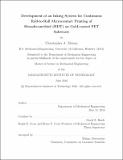Development of an inking system for continuous roll-to-roll microcontact printing of hexadecanethiol (HDT) on gold-coated PET
Author(s)
Merian, Christopher A
DownloadFull printable version (33.74Mb)
Other Contributors
Massachusetts Institute of Technology. Department of Mechanical Engineering.
Advisor
David E. Hardt.
Terms of use
Metadata
Show full item recordAbstract
Microcontact printing is a form of soft lithography that employs a molded polymer stamp to print substrates with pattern features as small as the sub-micron range. This is traditionally a plate-to-plate printing process, employing both flat stamps and flat, rigid substrates. However, to utilize this patterning technique in a truly low cost manner, it must evolve to a scalable roll-to-roll process. This combination of high precision patterning with high throughput manufacturing techniques could both reduce cost of current products, as well as enable a range of new technologies. Large area, high rate, continuous microcontact printing could be used to make flexible displays, photovoltaic dust sensors, and large area sensors among other products. This works describes the development of an inking system to enable continuous, roll-to-roll microcontact printing on a lab-scale machine. The molecular ink hexadecanethiol (HDT) is used to print self-assembling monolayers (SAMs) on flexible, gold-coated PET substrate. An ink tank and dryer system are designed and built to enable this material combination to be printed in a continuous manner. Measurement of print quality and pattern replication is executed to confirm that the system per- forms suitably at high throughput. The employment of the inking system facilitates a continuous, roll-to-roll microcontact printing process which can be used to further develop this manufacturing strategy.
Description
Thesis: S.M., Massachusetts Institute of Technology, Department of Mechanical Engineering, 2016. This electronic version was submitted by the student author. The certified thesis is available in the Institute Archives and Special Collections. Cataloged from student-submitted PDF version of thesis. Includes bibliographical references (pages 111-114).
Date issued
2016Department
Massachusetts Institute of Technology. Department of Mechanical EngineeringPublisher
Massachusetts Institute of Technology
Keywords
Mechanical Engineering.